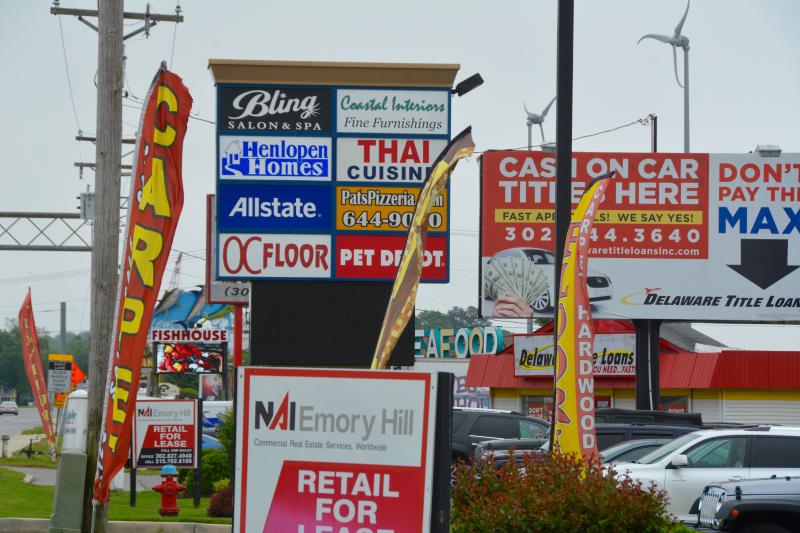Digital signs. Temporary signs. Billboards. V-signs. Any signs? No signs?
The back-and-forth about what do with the proliferation of commercial signs throughout Sussex County continued June 21 as Sussex County Council members debated details of a new sign ordinance.
“The whole proposal says off-premises signs, our moratorium is on off-premises signs, and two-thirds of what we're talking about are on-premises signs,” said council President Michael Vincent. “I just think there are so many things that we're trying to throw together, that we're talking about, that weren't in the original mix of things. To some people, it gets confusing.”
REACHING A CONSENSUS
County council members discussed several of 17 specific details of the new sign ordinance during the June 21 meeting. While they did not reach a consensus on all topics, agreement was reached on the following issues:
-A sign will be considered abandoned after six months. Debate continued on the definition of “abandoned.”
-V-signs will be permitted, but parameters on permitted angles are still up in the air.
-A 40-foot front-yard setback and a 50-foot side-yard setback will be required for all billboards, an increase from 25 feet for front yards, 20 or 50 feet for side yards, depending on sign size.
-Off-premises signs must be at least 150 feet from the property line of churches, schools, dwellings or public lands; this was previously measured from the building.
-Off-premises signs must be at least 50 feet from on-premises signs.
-Traditional billboards must be at least 600 feet apart, an increase from the current 300 feet.
For County Councilman George Cole, preserving the rural feel in some parts of Sussex County is not confusing. Throughout most of the hour-plus discussion, Cole advocated for larger buffers between signs and properties, and he proposed a complete ban on off-premises digital billboards – large signs that promote a business or company at a location other than where the business is found – on two-lane roads.
“When it comes to digital signs on two-lane roads, like Route 9, 24, 17, I think we don't need, in Sussex County, digital signs. A static sign is fine with me,” Cole said. “I think the majority of people in Sussex County would support my position of a prohibition of digital signs on two-lane roads because I think the big ire has been since the digital signs started popping up.”
But, Vincent said, the public isn’t speaking up.
“I don't question that people have said something to George Cole or whoever, but this has been our fifth time reviewing this, and I have yet to have one person from the public say anything,” he said. “The public isn't showing up, so they can't be too upset.”
While other council members supported many of Cole's other suggestions - increasing front- and side-yard setbacks and establishing a minimum distance between on-premises signs and billboards – Councilman Rob Arlett adamantly opposed his suggestion to ban digital signs on Sussex County backroads.
“I'm not confident you'll get three votes on that one,” Arlett said. “To me, it's total discrimination against the business owner. ... Complete prohibition is a little extreme.”
Still, Cole and Arlett agreed on establishing consistent sign buffers – from property lines, other signs and businesses – that will make it easier for county staff to enforce the new ordinance once it is finalized.
In some cases, including the distance between signs and schools or the distance between billboards, current code works in increments of 300 feet, Arlett said, which led him to propose a 600-foot distance between billboards, instead of the proposed 500 or 1,000 feet.
“I would offer that we would go in increments of 300, based on what we currently have, for simplicity,” he said. “Right now, you have separations all based on 300 feet. All of a sudden, you throw an odd number in there, like 500, so I would offer 600 instead of 500 because it doubles the current increment.”
“I’d like 1,000, but I don’t think I’ll get 1,000,” Cole said. “Your increments of 300 make some kind of sense, as I think about it. I’m comfortable with 600 feet.”
Similarly, a consensus was reached to choose a buffer of 150 feet between off-premises signs and the property line of churches, schools, dwellings and public lands.
Reviewing details and establishing specific measurements for the updated ordinance has been a more daunting task than expected, Vincent said.
“None of us knew how in-depth and how big of a deal this would be,” he said. “I didn’t think we’d be here, near the end of June, still talking about signs. But we are.”
Council members also reviewed whether V-signs, or two billboards, side by side, angled toward different lanes of traffic, should be permitted. Council agreed that they should be allowed, but called for tighter restrictions on the angle required, so that V-signs could not be used as one, large, double billboard. Current regulations allow V-signs to be constructed at an angle of less than 180 degrees.
“In some ways, who cares?” Arlett said. “I think your concern is when you have two signs being utilized as one. Maybe the answer is to prevent one, big sign.”
Cole suggested a compromise at 60-degree angles for V-signs, but the discussion was ultimately tabled as council ran out of time to address all the details in the proposed ordinance. No votes were taken on any of the topics discussed.
Council discussed similar sign-ordinance options for nearly four hours at its June 7 meeting, where members reviewed three versions of the proposed ordinance and suggestions from legal staff and planning and zoning commissioners. Council still has 17 items to address and finalize before the ordinance can move forward. Discussion is expected to continue at council's next scheduled meeting at 10 a.m., Tuesday, June 28.
A moratorium on new billboard construction, which expired June 15 after an initial three-month extension, has now been extended to Monday, Aug. 15, to allow additional time to rewrite the sign ordinance. Once the ordinance is adopted, public hearings will be scheduled.























































